Through the Looking Glass
His [Duchamp] finest work is his use of time.
—Jean-Pierre Roché
In the wake of his pictorial efforts and concomitant with the discovery of the ready-mades, Duchamp began a series of sketches and works that culminate in the production of The Bride Stripped Bare by Her Bachelors, Even, also known as The Large Glass (figs. 20, 21). The sheer duration of this work (which took eight years to evolve and was "finally unfinished" in 1923) and its accidental completion (it cracked in 1926 while in transit from its first public showing to its owner Katherine Dreier), reveal the magnitude of Duchamp's desire to leave traditional forms of art behind.[59] As he explained to Cabanne: "Art was finished for me. Only the 'Large Glass' interested me." (DMD, 41). Considered as Duchamp's major opus, this work has elicited enormous critical reflection and engendered many debates in regard to its meaning and significance. As Calvin Tomkins observes:
The Large Glass stands in relation to painting as Finnegan's Wake does to literature, isolated and inimitable; it has been called everything from a masterpiece to a tremendous hoax, and to this day there are no standards by which it can be judged. Duchamp invented a new physics to explain its "laws," a new mathematics to fix the units of measurement of the new physics, and a condensed, poetic language to formulate its ideas, which he jotted down on scraps of paper as they occurred to him and stored away in a green cardboard box for future reference.[60]
Despite its visual transparency, or perhaps because of it, this work continues to resist definitive critical appropriations. Like the viewer's body, which is inscribed in this work as the tain, or silver backside, of a mirror, this
work's opacity most often reflects the presuppositions of the critical discourses that have sought to illuminate it.[61] My purpose in this study is not to provide a definitive account of The Large Glass, since it may be impossible to do so, but rather to use it as a vehicle, as a looking glass—a context for understanding Duchamp's particular passage through art as he explores the very limits of its conditions of possibility and its potential future.
When challenged by Pierre Cabanne to provide his own interpretation of The Large Glass, Duchamp responded:
I don't have any, because I made it without an idea. There were things that came along as I worked. The idea of the ensemble was purely and simply the execution, more than descriptions of each part in the manner of the catalogue of the "Arms of Saint-Etienne." It was a renunciation of all aesthetics in the ordinary sense of the word . . . not just another manifesto of new painting. (DMD , 42)
Duchamp's reluctance to provide an interpretation of his own work should not be understood as a mere refusal, as evasiveness, or as a sign of the work's intelligibility. Rather, Duchamp's statement repositions the significance of this work as a process: a repository of meaning not as given but as generated by the spectator through his or her active interplay with the work. The idea of this work does not function as a mere blueprint; rather, the logic of the ensemble emerges through the execution and assemblage of its specific elements. Using the analogy to the Arms of Saint-Etienne (the early twentieth-century French equivalent of a Sears and Roebuck catalog), Duchamp underlines the encyclopedic character of this work, as well as its ready-made logic.[62] By referring to a logic of assemblage whose nature is not artistic but technical and commercial, Duchamp is able to enact his renunciation of traditional aesthetics. His insistence that this work does not represent "just another manifesto of new painting," marks his effort to redefine aesthetics by invoking the mechanical logic of media of mass production, such as printing, engraving, and photography. The Large Glass thus represents "a sum of experiments," without the idea of creating yet another movement in painting, in the sense of Impressionism, Fauvism, or, for that matter, the contemporary Cubist and Futurist avant-gardes of the period.
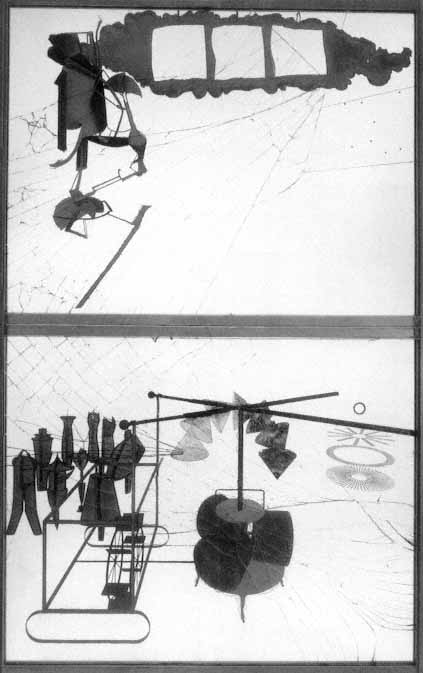
Fig. 20.
Marcel Duchamp, The Bride Stripped Bare By Her Bachelors, Even, or The Large
Glass (La Mariée mise à nu par ses Célibataires, Méme), 1915–23. Oil,
varnish, lead foil and wire, and dust on glass mounted between two glass panels,
9 ft. x 1 1/4 in. x 5 ft, 9 1/4 in.
Courtesy of The Philadelphia Museum of Art, Katherine S. Dreier Bequest.
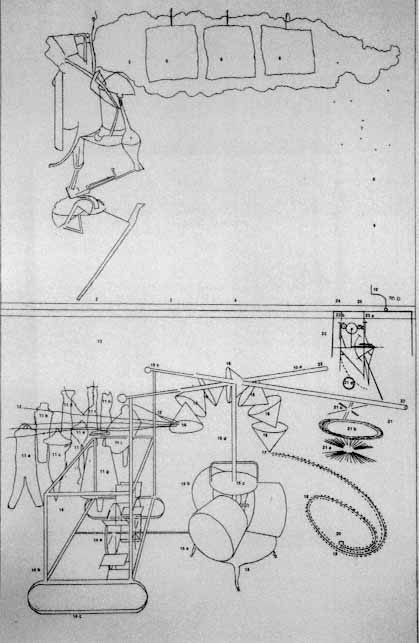
Fig. 21.
Diagram based on Marcel Duchamp's etching, The Large Glass Completed, 1965.
Courtesy of The Philadelphia Museum of Art.
The idea of the glass as a compendium of experiments is further compounded by the fact that the spectator's visual experience of it is intended to be mediated by the intervention of Duchamp's notes in a box. As he explains to Cabanne:
For the "Box" of 1913–1914, it's different. I didn't have the idea of a box as much as just notes. I thought I could collect, in an album like the Saint-Etienne catalogue, some calculations, some reflections, without relating them. Sometimes they're on torn pieces of paper. . . . I wanted that album to go with the "Glass," and to be consulted when seeing the "Glass" because, as I see it, it must not be "looked at" in the aesthetic sense of the word. One must consult the book, and see the two together. The conjunction of the two things entirely removes the retinal aspect that I don't like. It was very logical. (DMD, 42–43)
The notes, calculations, and speculations that are part of the "Box" constitute a catalog, an arbitrary inventory of items to be consulted when looking at The Large Glass. The conjunction of written and visual information disrupts the visual consumption of the Glass by interfering with its "retinal" character. The act of vision is contextualized, thereby redefining the aesthetic autonomy of the Glass . As Duchamp explains: "The Glass is not to be looked at for itself but only as a function of a catalogue that I never made."[63] Although Duchamp did not produce an actual catalog to accompany The Large Glass, his comment indicates that the Box of 1914 (Boîte de 1914 ; 1913–14) (fig. 22) is intended to serve as its companion piece.[64] By designating the Box of 1914 as a kind of manual to the Glass , Duchamp emphasizes the conditions of its production. In doing so he removes the Glass from the aesthetic realm by introducing technical considerations. By mediating the perception of the Glass through the Box of 1914, Duchamp redefines the Glass not as an object in its own right but as a prototype, a blueprint of sorts, whose function is to redefine through industry the very meaning of art.
Duchamp's appeal to mechanical drawing as a way of challenging painting is a "reaction against the easy splashing way," reflecting his continued struggle: "I was fighting against the hand."[65] Considered in
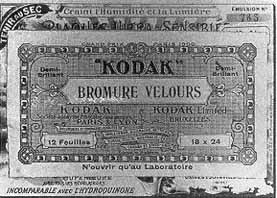
Fig. 22.
Marcel Duchamp, The Box of 1914 (Boîte de 1914), 1913–14.
Kodak photographic box containing sixteen photos of manuscript
pages and one of the design. To Have the Apprentice in the Sun,
9 7/8 x 7 1/4 in. Galleria Schwarz, Milan, Courtesy of Arturo Schwarz.
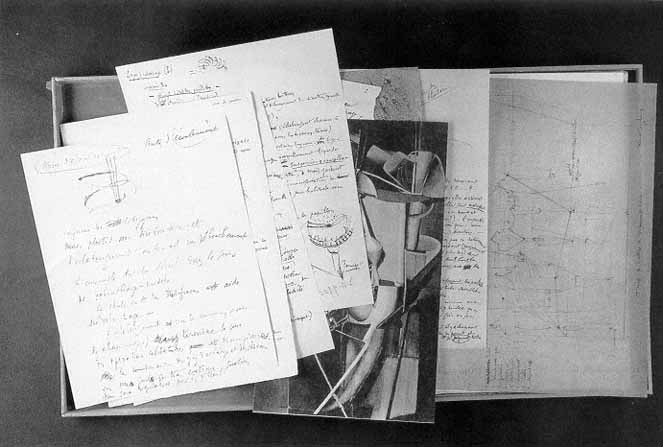
Fig. 23.
Marcel Duchamp, The Bride Stripped Bare By Her Bachelors, Even (La Mariée mise à nu par ses Célibataries,
Même) from The Green Box, 1934. 8 x 10 in.
Courtesy of The Philadelphia Museum of Art, Louise and Walter Arensberg
light of the Box of 1914, and the subsequent Green Box (1934) (fig. 23), which bears the same title as The Large Glass (The Bride Stripped Bare by Her Bachelors, Even), the Large Glass emerges as a compilation of various forms of mechanical reproduction, a work whose transitional status reflects Duchamp's efforts to challenge pictorial conventions through mechanical drawing.[66] Duchamp's use of mechanical drawing, however, reflects his effort to move away from pictorial representation by appealing to a form of schematism that relies on both visual and discursive cues. As he explains to Francis Roberts: "My approach to the machine was completely ironic. I made only the hood. It was a symbolic way of explaining. What was really beneath the hood, how it really worked, did not interest me. I had my own system quite tight as a system, but not organized logically."[67] Duchamp's experiments with mechanical drawing and other forms of technical reproduction are not based on physical or scientific principles; instead, they represent a "symbolic way of explaining," one that privileges the logic of the machine, only to reveal its ironic underpinnings. Commenting on Duchamp's annotations on the painted Bride, Richard Hamilton observes that: "They are an after-the-fact determination of a possible physical nature and operation, justifying the fortuitous disposition of forms which would be abstract if they did not give a strong illusion of existence and if some alien causality could not be read into them."[68] Using straightforward descriptions that are as exact as those of a "patent engineer," Duchamp hints that the fortuitous visual appearance of the Bride may be the expression of some form of physical causality, a manifestation of hidden physical laws and operations.
The Large Glass thus embodies both Duchamp's appeal to technical means of production and the machine, only to discredit through this very fidelity the logic of science. But why challenge painting by introducing scientific and technical considerations, only to humor them in turn? The answer, as provided by Duchamp, is quite simple:
All painting beginning with Impressionism, is antiscientific, even Seurat. I was interested in introducing the precise and exact aspect of science, which hasn't often been done, or at least hadn't been talked about very much. It wasn't for the love of science that I did
this; on the contrary, it was rather in order to discredit it, mildly, lightly, unimportantly. But irony was present. (DMD, 39)
Duchamp's appeal to science is merely a vehicle for irony, a way of distancing himself from painting in order to discover in the literal logic of technical terminology a new kind of poetic device. The Large Glass becomes a looking glass, a mirror of various forms of literal and visual transposition whose technical precision and exactitude undermines the plasticity of painting through the poetry of scientific redundancy. Duchamp's description of this work as "a wedding of mental and visual concepts" makes us aware that the ceremony that The Bride Stripped Bare by Her Bachelors, Even enacts may involve a symbolic union, one whose seamless appearance and transparency reflects the opacity of the artistic and technical processes that constitute it.[69]
Duchamp's comments on the Large Glass underline his desire to abandon oil painting and the artistic conventions it involves. As Duchamp explains: "From Munich on, I had the idea of the Large Glass. I was finished with Cubism and with movement—at least movement mixed up with oil paint. The whole trend of painting was something I don't care to continue. After ten years of painting I was bored with it."[70] As the analysis of his painting The PASSAGE from the Virgin to the Bride (from the Munich period) has demonstrated, however, Duchamp's desire to strip painting bare by redefining it as a transitional activity, as a set of impressions or imprints, leads to the redefinition of this work as a strategy of delays. This work defines a passage through painting as it is being reconceptualized through engraving, that is, a process of drawing upon painting as a way of challenging pictorial conventions and the confines of pictorial space. The subtitle of The Bride Stripped Bare by Her Bachelors, Even, "Delay in Glass" ("Retard en Verre "), attests to Duchamp's continued efforts to move beyond the notion of painting by refusing to assimilate this work to a "picture on glass":
Use "delay" instead of picture or painting; picture on glass becomes delay in glass—but delay in glass does not mean picture on glass—
It's merely a way of succeeding in no longer thinking that the thing in question is a picture—to make a "delay" of it in the most
general way possible, not so much in the different meanings in which "delay" can be taken, but rather in their indecisive reunion "delay"—/a "delay in glass" as you would say a "poem in prose" or a spitoon in silver. (wmd, 26)
Duchamp introduces the notion of delay as a way of holding both painting and pictorial conventions at bay. This strategy of postponement or deferral does not involve the mere transposition of painting into another medium such as glass but rather, the redefinition of the medium itself in terms of a deferral, a passage that postpones the pictorial becoming of painting.
When asked by Francis Roberts why he felt compelled to paint on glass, Duchamp answered:
The main point is the subject, the figure. It needs no reference. It is not in relation. All that background on the canvas that had to be thought about, tactile space like wallpaper, all that garbage, I wanted to sweep it away. With the glass you can concentrate on the figure if you want and you can change the background if you want by moving the glass. The transparency of the glass plays for you. The question of painting in background is degrading for the painter. The thing you want to express is not in that background.[71]
By using the transparency of glass as a medium, Duchamp denies one of the signatory marks of painting, that of figure/ground relations. By using glass, Duchamp reduces the notion of pictorial background to a readymade, one that changes with the position of the glass. The referential relations between figure and background now emerge as no longer internal to the logic of the image, but as a product of its chance encounters with the world. This gesture liberates the subject matter of painting, the figure, from its referential relations to painting, as well as redefines it as a new site. This site is no longer governed by the regime of sight, of pictorial vision, but its deferral as pictorial becoming. The figure in this work is merely an allegorical appearance whose logic stages its own representational conventions as an apparition.
The Bride Stripped Bare by Her Bachelors, Even (The Large Glass ) is a multimedia work that combines oil, varnish, lead foil and wire, and dust
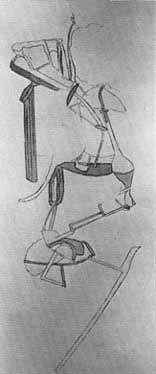
Fig. 24.
Marcel Duchamp, The Bride (Pendu
femelle), detail of The Large Glass, 1965.
Courtesy of The Museum of Modern
Art, New York
on glass mounted between two glass panels. Divided into two regions and separated by three fins of glass that are perpendicular to the plane of the work, they are described by Duchamp as belonging respectively to the Bride and the Bachelors (WMD, 39).[72] Both of these regions are generated as reflections and projections of his previous pictorial works: the literal transposition of the Munich Bride of 1912, oil on canvas, and The Chocolate Grinder, No. 1 (Broyeuse de chocolat, no. 1; 1913, oil on canvas) on the upper and lower panels of the Glass, respectively.[73]The Bride (Pendu femelle; 1965) (fig. 24) is a visual excerpt, a silhouette print of Duchamp's finger-painted Bride. Duchamp had attempted to transfer the painted Bride by projecting a negative of the Bride onto the surface of the glass treated with a photosensitive emulsion. Since this print did not develop properly, he then used lead fuse wire to draw the silhouette, which he painted in by using gradations of black and white, in order to simulate a photograph of the Bride. The deployment of these elaborate technical strategies for reproducing the Bride on glass, not in its original colors but as a black-and-white photograph, reveals that the graphic dimensions of this work may be less in its iconographic content than in the projection of the material and technical conditions of its production as a reproduction. Duchamp's efforts to strip bare painting coincide with a strategy of reproduction of the Bride, one that delays its pictorial becoming through its deferral as a series of impressions, as photographic or engraved prints.
Such a conclusion could seem farfetched, were it not to be understood in light of Duchamp's consistent efforts to challenge painting by rethinking the functions of different media of mechanical reproduction, such as engraving, photography, and cinema. These allusions to mechanical reproduction constitute both the subject matter and metaphorical subtext of his notes. In the Green Box Duchamp refers to the upper region of the Bride's domain, The Top Inscription (1965) (fig. 25), as the "cinematic blossoming":
Grafting itself on the arbor type—the cinematic blossoming (controlled by the electrical stripping)/ This cinematic blossoming is the most important part of the painting. (graphically as a surface)/ It is in general, the halo of the bride, the sum total of her splendid vibrations: graphically, there is no question of symbolizing by a
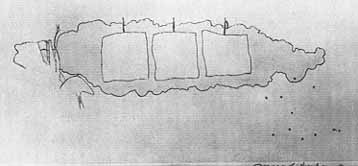
Fig. 25.
Marcel Duchamp, The Top Inscription, detail of The Large Glass, 1965
Wash study on handmade paper for the second state of the etching
of the same subject.
Courtesy of The Museum of Modern Art, New York.
grandiose painting this happy goal—the bride's desire; only more clearly, in all this blossoming, the painting will be an inventory of the elements of this blossoming, elements of the sexual life imagined by her bride-desiring. (WMD, 42)
Duchamp's graphic rendering of this "cinematic blossoming" is not symbolic but literal to the extent that the surface of caption is punctuated by the three exposures of draft pistons. The Draft Piston (Piston de courant d'air; 1914) (fig. 26) is a photograph of a plane of square gauze or netting material in front of an open window that assumes different shapes when moved about by air drafts. As Duchamp explains: "I wanted to register the changes in the surface of that square, and use in my Glass the curves of the lines distorted by the wind. So I used a gauze, which has natural straight lines. When at rest, the gauze was perfectly square—like a chessboard—and the lines perfectly straight—as in the case of graph paper."[74] Embedding both allusions to chess and chance, and specifically to his Three Standard Stoppages, Draft Piston contextualizes chance events as a series of imprints whose plasticity undermines pictorial modes of production through mechanical reproduction. The Bride's "cinematic blossoming" thus coincides with her "electrical stripping." It emanates like a halo constituting the aura of the Bride, "the sum total of her splendid vibrations." It corresponds to the inventory of her literal development through different modes of mechanical impression, since the gauze acts as a free floating screen ("a very fine 'sculpture' of skill," to use Duchamp's terms), which is photographed only to have its imprints manually transposed onto
the glass in the manner of engraving. Duchamp's appeal to the "graphic" in the context of the Glass serves to underline his efforts to "draw" on painting while redefining its meaning through reproductive techniques.
Such a technical reading of the "blossoming" and "stripping" of the Bride appears, however, to overlook the sexual overtones of Duchamp's formulation of "cinematic blossoming" as the "elements of the sexual life imagined by her bride-desiring." The very designation of the Bride as the "hanged" (pendu; a masculine term in French), followed by the adjective female (femelle ), inscribes the specter of gender ambiguity and reversal into her/his supposed blossoming.[75] The term "hanged" is associated with the public display of painting, handled by "hanging committees." Could it be, then, that the sexual blossoming of the Bride alludes to gender, only to make manifest the process of engenderment? The suspension of the Bride's pictorial and iconographic identity is captured precisely in her/his development through mechanical reproduction. It is the Bride's nonidentity as a pictorial entity that justifies painting's "blossoming" as a multiple mechanism of irony. The painted Bride's "cinematic development" on glass coincides with its suspension as a pictorial artifact, while this work's emergence as nonart coincides with its ironic destiny as a machine. Having literally hanged painting out to dry, Duchamp uncovers within its conceptual potential a generative mechanism, whose very blossoming engenders its demise.
The notion of chance that subtends the mechanical operations of the Bride is revealed by the Nine Shots, a group of nine holes drilled into the glass, underneath and to the right of the Top Inscription. Using a match dipped in paint and a toy cannon, Duchamp aimed shots at a target point that "corresponds to the vanishing point (in perspective)," leading each
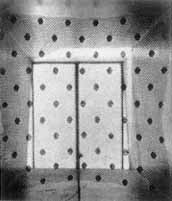
Fig. 16
Marcel Duchamp, Draft Piston (piston De
Courant D'air), 1914. Gelatin silver print,
23 1/8 x 19 3/4 in.
Courtesy of The Philadelphia Museum of Art.
time (the process was repeated three times) to generating three points. This projection results in a "demultiplication of the target," representing the "schema of any object whatever" (WMD, 35). The multiplication of the target also coincides with the "demultiplied body," which is a system that represents its plasticity according to rules whose logic is flexible. Taking potshots at painting and its perspectival conventions, Duchamp's projections of the painted Bride emerge as reflections of his effort to rethink the plasticity of painting according to laws whose mechanical and technical nature is poetic, rather than physical.
The experiments of the Bride region of the Large Glass cast Duchamp's interest in science, and particularly the fourth dimension, in a new light. Duchamp himself admitted that he understood non-Euclidian geometry as "a way of thinking about art on a broader scale."[76] Speaking about the Bride and the fourth dimension, he explains that the Bride is the expression of a system of multidimensional projections:
Anything that has a three-dimensional form is the projection in our world from a four-dimensional world, and my Bride, for example, would be a three-dimensional projection of a four-dimensional bride. All right. Then, since it's on glass it's flat, and so my Bride is a two-dimensional representation of a three-dimensional Bride, who also would be a four-dimensional projection on a three-dimensional world of the Bride.[77]
Duchamp's technical account of the Bride as a four-dimensional projection into our three-dimensional world may involve more than a simple account of Duchamp's fascination with four-dimensional geometry. His statements regarding geometry, where the appearance of an object or image is conceived as the result of a system of mathematical projection, may also be seen as a metaphorical reflection on art.[78] Could Duchamp be using the notion of perspective as an analogy for the effort of putting the concept of art itself, in perspective, as it were?
If classical perspective is the expression of geometrical illusionism, then Duchamp's attempt to redefine art may be the expression of an ironic approach to geometry. The Bride as pictorial referent, as the result of a system of geometric projections, is undermined by her literal transposition
onto the Glass . Duchamp draws on the painted Bride, only to delay the impact of its becoming as pictorial event. Duchamp's literal reproduction of the pictorial Bride on glass reduces her to a ready-made, one whose mechanical existence is simulated by her appearance as a photograph or engraving. The redundancy of the Bride, achieved through reproduction, derealizes her pictorial uniqueness by presenting her, not as a unique entity but as a multiple one. The very fidelity of her reproduction on glass reflects back on the pictorial original to undermine its unique identity. The reproduction of the Bride is a perfect projection, insofar as it involves literal transposition, but, given the reversibility of the glass, fidelity to geometry emerges as a pun with an ironic twist. By conflating the work of art with the mimetic impulse that subtends it, Duchamp literalizes the dilemma of the work of art in the age of mechanical reproduction by putting it in front of amirror. But like other mirrors, the Glass reflects art perfectly backward, reducing its visual appearance to the logic of puns. A linguistic pun, however, like visual puns, wrecks havoc with meaning, since the reversibility of terms undermines the conventions of meaning.
The strategies of reproduction deployed in the Bride region of the Glass are pursued consistently and with exactitude in the lower half of the glass. Duchamp proceeds to reproduce on glass several of his previous works, most notably Chocolate Grinder, No. 2 (Broyeuse de chocolat, no. 2 ; 1914) (fig. 17). By reproducing the Chocolate Grinder on glass, Duchamp
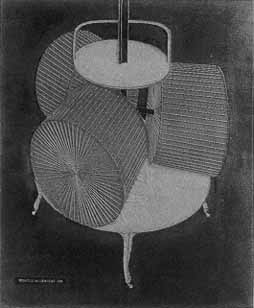
Fig. 27
Marcel Duchamp, Chocolate Grinder, No. 2 (Broyeuse
De Chocolat, No. 2), 1914. Oil and thread on canvas,
25 5/8 x 21 1/4 in.
Courtesy of The Philadelphia Museum of Art,
Louise and Walter Arensberg Collection.
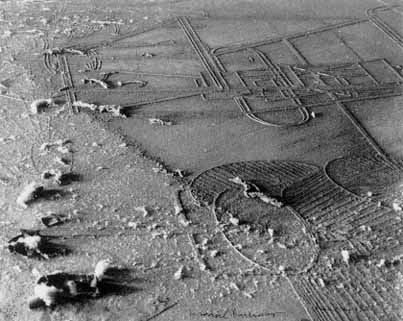
Fig. 28
Marcel Duchamp, Dust Breeding (Elevage De Poussière), 1920. Photograph taken by
Man Ray of dust in the region of the Sieves on the Large Glass. Galleria Schwrz, Milan.
Courtesy of Arturo Schwarz.
brings to completion a pictorial series that started with Chocolate Grinder, No. 1, in 1913. The significance of this work, as Duchamp describes it, resides in the fact that it led him to think that he "could avoid all contact with traditional painting" (DMD, 37). An instance of Duchamp's interest in mechanical drawing, this work represents the beginning of Duchamp's investigation of a "dry form of art," that is, by capturing its physical qualities as a machine as objectively as possible.[79] Duchamp's interest in the chocolate grinder as a commercial machine reflects his effort to move beyond the notion of pictorial color as artisanal activity, since "The bachelor grinds chocolate himself" (WMD , 68). But why the analogy between chocolate and color? Under the rubric of "Color" in the Green Box, Duchamp suggests that the solidity of chocolate as a sculptural mold enables one to conceive of color ("physical dyeing") as an "apparition in the negative of the apparent colors of the substance of the objects" (WMD, 70). In this context color is redefined, not as an inherent quality but as the product of a system of conceptual projections.
Right above the Chocolate Grinder, and crossing the moving axis of
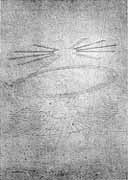
Fig. 29
Marcel Duchamp, Oculist Witnesses
(TéMoins Oculistes), 1920. Pencil on
the reverse of a carbon paper, 19 3/4 x 14 3/4 in.
Courtesy of The Philadelphia Museum of Art,
Louise and Walter Arensberg Collection.
the Scissors, are the Sieves or Parasols, seven cones that resemble cones used in seventeenth-century treatises on perspective and anamorphic imagery, where their function was to either construct or correct visual distortion.[80] In the Green Box the Sieves are described as a "reversed image of porosity" (WMD , 53), a pun on the "breeding dust" that was "raised" on the Glass for a period of several months, then carefully graded in concentration, before being fixed with varnish. This section of the Glass was photographed by Man Ray and entitled Dust Breeding (Elevage de poussière; 1920) (fig.28).[81] According to Duchamp, "this dust will be a kind of color" (WMD , 53), suggesting that this miniature relief, or molded terrain, undermines the primacy of color through its perspectival effects. The temporal delays involved in the sedimentation of dust, as well as its lack of distinctive color, become in this instance the generators of a nonpictorial kind of color whose dryness and porosity argue against the liquidity of paint. If the Glass is a "greenhouse" of sorts, the colors that it breeds are not those of traditional painting.[82] By analogy to perspective ("perspective resembles color," WMD, 87), color in this context emerges as a projection of time, a delay whose imprint actively holds painting at bay.
In 1918, as a way of further emphasizing his particular interpretation of color, Duchamp added to the right corner of Glass the Oculist Witnesses (Témoins oculistes; 1920, a French term for eyewitnesses) (fig. 29), a ready-made oculist chart that Duchamp multiplied three times and placed one above the other. These shimmering rings were reproduced by working in the negative, on the back side of the glass, through a process of laboriously scraping away excess silver. The transposition of the commercial eye charts bears further witness to the fact that the visual appearance of the Glass may be in the order of a visual trick or a pun, a set of projections that must be looked at "cross-eyed, like a piece of silvered glass, in which are reflected the objects in the room" (WMD , 65). In his notes Duchamp also describes this section as a "Sculpture of drops (points) which the splash forms after having been dazzled across the oculist charts, each drop acting as a point and sent back mirrorically to the high part of the glass to meet the 9 shots=/Mirrorical return" (WMD , 65). The ocular mirages engineered by the eye charts emerge as mechanisms of projection, which instead of mirroring external reality reflect the very mechanisms of projection that structure the glass, connecting mirrorically its upper and
lower region. The Glass is thus a folding mirror that reflects back upon itself, a looking glass that transforms the spectator's view into a play of reflections whose visual logic has been reified through puns.
Connected to the Scissors above the Chocolate Grinder and to the Sieves, the Capillary Tubes act as a conduit for the Illuminating Gas that circulates from the Nine Malic Molds to the rest of the Glass. In order to generate the network of lines of the Capillary Tubes Duchamp reproduced his painting Network of Stoppages, which is a reproduction of his earlier experiments with chance in Three Standard Stoppages. Having originally "canned chance" by capturing the outlines of three fallen strings on templates, he later used each template three times to map out a set of imprints that trace a network of lines. Duchamp multiplies the original imprint of chance by generating a network of lines, whose graphic character draws upon and plastically elaborates his initial experiment. Through multiple reproductions of this work of "canned chance," Duchamp redeploys chance in his work as a plastic device whose formal appearance generated by accident informs the shape of the precisely crafted elements of the Large Glass. Rather than functioning merely as a conduit, the Capillary Tubes draw one's attention to the notion of reproduction, not merely as a vehicle but as a generator of plastic and conceptual effects. The mechanical aspects of reproduction are recuperated in the service of forms of production that challenge traditional artistic conventions.
On the left-hand side of the lower region of the Glass are the Nine Malic Molds (9 moules mâlic; 1914–15) (fig. 30), whose position coincides with the Bride in the upper quadrant. Also entitled the Eros Matrix and forming the Cemeteries of Uniforms and Liveries, the Nine Malic Molds look like hollow shells or dressmakers' dummies. Like dressmakers' patterns that outline three-dimensional form on a two-dimensional surface, the Nine Malic Molds are "uniforms or hollow liveries" destined to give form to the illuminating gas (WMD , 51).[83] They are "gas castings," inflated forms that parody social positions: the Priest, Delivery Boy, Gendarme, Cavalryman, Policeman, Undertaker, Flunky (liveried servant), Busboy, and Stationmaster. Absent from this schema is the Artist, the social medium par excellence, who functions ostensibly as society's mirror. Unless, that is, the Artist embodies the plurality or types of social positions designated above as afigurative die or mold. The distinctive
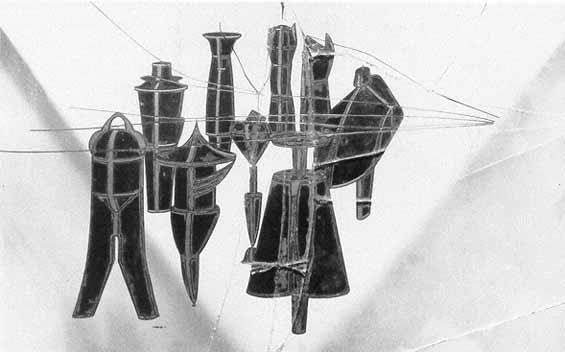
Fig. 30
Marcel Duchamp, Nine Malic Molds (9 Moules Mâlic), 1914–15. Oil, wire, and glass, 21 1/8 x 39 3/4 in.
Courtesy of The Philadelphia Museum of Art, Louise and Walter Arensberg Collection.
costumes that comprise the Nine Malic Molds (alluded to in the subtitle Cemeteries of Uniforms and Liveries) indicate Duchamp's attempt to redefine the service that the artist owes to both society and art. As the previous analysis of The PASSAGE from the Virgin to the Bride has shown, Duchamp is no ordinary attendant to painting. He is not its "groom," since he neither equips it nor dresses it up, but rather draws on it conceptually. The illuminating "gas" that takes or receives the form of the Nine Malic Molds thus emerges as a pun on the "gaze," illuminating the institutional conventions of painting only to reify it as a visual practice.
The designation of the Nine Malic Molds as Eros Matrix inscribes a feminine dimension into this bachelor machine or apparatus. Their visual appearance as dressmaking patterns creates an ambiguity between the exterior and the interior (malic/matrix), an ambiguity that reflects the mechanics of projection in the Glass, since the feminine matrix is also a masculine mold.[84] The ambiguity of projection mechanisms in the Glass,
based on notions of form turned inside out, suggests that gender itself may be a rhetorical operation. Duchamp's specification regarding the alignment of the Nine Malic Molds that each of the forms is "built above and below a common horizontal plane, the plane of sex cutting them at the pnt. of sex" (WMD , 51), suggests that sexuality is presented as a system of projection, by analogy to a perspectival model. The gender ambiguity of the Nine Malic Molds is engendered by notions of artistic production redefined through reproduction. The multiplication of personality embodied in the Nine Malic Molds is the result of strategies of reproduction that defer the traditional notion of authorship as a unitary entity, by representing it as a compound of different personae and gender identities. In The Bride Stripped Bare by Her Bachelors, Even the stripping bare of painting coincides with the dressing up of the artist, who emerges as a multiple of himself/herself. The creative act is redefined as an act of dispossession, one that delivers the artist from the obligation of perpetuating the conventions of traditional painting, as well as perpetrating the myth of his or her own identity.[85] By strategically redeploying the notion of painting through reproduction, Duchamp redefines both the meaning of art as product, and the artist as a unique maker or producer.
Richard Hamilton has noted that "the Bride's irregular organic shapes and hinged, flexing relationships are contrasted with the Bachelor's predetermined, mensurated, rectilinear planning and simple mechanical movements."[86] These iconographic differences between the two regions of the Glass are not to be taken at face value as mere rationalizations of gender positions, where the feminine is equated with organic forms, while the masculine is equated with mathematical forms of rationality. While both regions of the Glass emphasize reproduction both as a process of production and as conceptual intervention, the iconographic differences indicate that these two regions may be associated with different interpretations, and hence, treatments of painting and pictorial conventions. Despite the excesses of lubricious behavior attributed to the Bride, her reproduction as a photographic negative accompanied by her cloudy and drafty blossoming suggests that whatever liquidity was involved in herpainterly fate has evaporated and turned into gas. An heir to painting, the Bride's projections have reified and dried out her painterly pretensions by subjecting her to repeated drafts (draughts). She now emerges as an instance of dry
art: more like air (heir), than art (arhhe), understood in the conventional sense. And the Bachelor Machine? Although seemingly more masculine because it is more measured and precise, the lower part of the glass turns out to be a spoof on rationality. The machines represented in this section, the chocolate grinder, the glider, the malic molds, the sieves, and the capillary tubes, are all machines that deal with the production of pigment, of painting defined as an art of color: a veritable waterfall associated with painting understood as "the splashing of paint."
This insistence on the retinal aspects of painting is emphasized by the presence of the oculist witnesses and other puns on the viewer's gaze, which liquefy painterly reality by drawing our attention to its material character. Despite its mechanical and schematic nature, the lower half of the glass functions as a "greenhouse" for "breeding colors," which like ephemeral perfumes caution the viewer to the fact that the "fruit still has to avoid being eaten" (WMD , 70). The Bachelor Apparatus emerges, therefore, as an elaborate spoof of pictoriality and the painterly gaze, that is to say the aesthetic, despite its technical pretensions. Thus, both sections of the Glass wreck havoc with the viewer's expectations, insofar as these regions defy traditional gender qualifications.
Duchamp's deliberate choice to place the three ready-mades Paris Air (Air de Paris; 1919), Traveler's Folding Item (Pliant de voyage ; 1916) and Fountain (1917), respectively, above, in the middle, and below, coinciding with the three regions of the reproduction of the Large Glass, in the Green Box (1934) and The Box in a Valise (1941), helps elucidate its meaning further. On Walter Hopps's query at Duchamp's retrospective exhibition at the Pasadena Art Museum, Duchamp responded that these three ready-mades were like "ready-made talk of what goes on in the Glass."[87] Duchamp's comment is quite telling, to the extent that it suggests that the logic of the Glass is in the order of the ready-mades, that is, a principle of reproduction whose sequential order may be collapsible, pliant, or flexible, like the middle section of the Glass that corresponds to Duchamp's ready-made Traveler's Folding Item (Pliant de voyage ). The transparency (transparence ) of glass allows the two sections of the glass to fold on each other, like a collapsible hood. By defining visual appearance, in the mode of apparition, Duchamp defies a filiational or genealogical model. The collapse, and thus the coincidence of the upper and lower
regions of the Glass, may be seen as a pun on its transparency (transparent ), understood literally, not just as appearance but also as across or beyond (trans ) filiation or kinship (parent ).
This appeal to filiation, in the context of a discussion on modes of appearance, might seem trivial, were it not for the fact that Duchamp's critique of the notion of artistic production through reproduction undermines the notion of artistic creativity and its filiational logic with the tradition. As Duchamp explains:
In the "Bride," in the "Glass," I tried constantly to find something which would not recall what had happened before. I have had an obsession about not using the same things. One has to be on guard because, despite oneself, one can become invaded by things of the past. Without wanting to, one puts in some detail. There, it was a constant battle to make an exact and complete break. (DMD , 38)
While Duchamp's Large Glass radically breaks with previous pictorial traditions, the irony is that Duchamp consistently reproduces previous works, thereby defining the Glass as a compendium of all his previous efforts. While distancing himself from the tradition, the Glass emerges as a corpus whose identity is defined through reproduction, as a process of contextualization. The Bride Stripped Bare by Her Bachelors, Even redefines artistic production according to the logic of reproduction, thereby inscribing gender as a pun into the mechanical and technical processes that orchestrate this work.
Despite its more traditional monumental and aesthetic character, The Large Glass announces Duchamp's abandonment of pictorial conventions and his elaboration of the notion of reproduction as an objectification of artistic traditions. The meaning of The Large Glass relies less on its ostensible subject matter, alluded to by the title The Bride Stripped Bare by Her Bachelors, Even, than on the manner in which it stages the notion of representation as a literal transposition and reproduction of his previous works. The nonsensical adverb "even" (même ) that qualifies the title and to which Duchamp ascribes no meaning, is also used in French as an adjective that signifies "same," or after a noun, "self" or "very," in a reflexive form. The pun on même as "even" or "same" suggests that the
reflective properties of The Large Glass implode in a mirage of reproducibility, a reiterative exploration of minute differences in a field of supposed identity or sameness. The explicit emphasis on reproduction in the Glass, specifically in regard to the transposition of pictorial images and idioms to glass by allusion to other media (such as photography and film) suggests its conceptual affinity to the project of the ready-mades, as instances of mechanical reproduction, and the miniature compendium of Duchamp's works in The Box in a Valise. Rather than envisioning The Large Glass as a unique monument that marks Duchamp's departure from and abandonment of painting, The Large Glass emerges as a commemorative work that plays upon the mimetic impulses of painting by literalizing them through puns on the notion of reproduction. The process of stripping painting bare coincides with the effort of making apparent the conventions that subtend the pictorial process.If gender appears in the context of this filiational enterprise it does so as a rhetorical gesture embedded in Duchamp's experiments to expand the generic meaning of painting. The discovery of this affiliation based on reproduction linking The Large Glass, the ready-mades, and The Box in a Valise, reveals that the heir of painting is a function of notions of artistic production redefined through reproduction. The mythical encounter between the bachelors and the bride, between painters, spectators, and painting, opens up the possibility of envisioning art as the postponement of painting's pictorial becoming. For what emerges through The Large Glass belongs less to what painting looks like than the return of a likeness on glass generated by drawing on painting, while redefining through this reflection its condition of possibility.